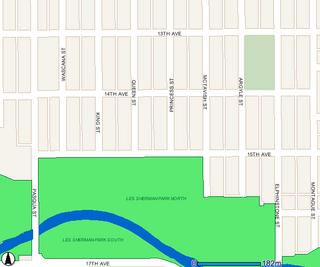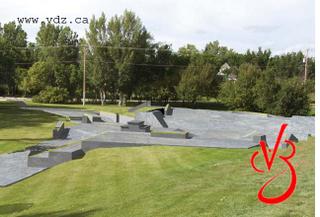Skatepark FAQs

Where is the location?
The proposed location is in North Les Sherman Park, also known as Turtle Park. Two possible sites are under consideration, one near 15th Ave., between the soccer pitch and the ball diamonds, and one just south of the Balkwill Centre. Both sites are outside the flood plain.
How was the location chosen?
A committee comprised of Regina Police Services, city officials and skateboarders ranked various sites, based partly on criteria developed at a user focus group meeting in November 2004. The ranking was based on things such as bus, bike and foot access; proximity to shelter; ability to integrate with existing landscape; safe and pleasant surroundings and support of location from skateboarders. North Les Sherman gained the most points; skateboarders themselves ranked it 25 out of 25. In February 2006, a series of public meetings gathered further input from residents and parents.
Who will use it?
The park will be planned with skateboarders in mind, although inline skaters and bikers will also make use of it. There are seldom more than 20 skaters at a time at the existing
Will it be noisy?
No. Skating is a quiet sport, and can be made even quieter through careful design and landscaping. Skaters tend not to cheer and shout (noises common at a baseball or soccer game). The average noise of a skatepark at 100 feet is 65 decibels, "comparable to the level of a moderate conversation between two individuals." (Noise Control Office, City of
Will there be lots of traffic?
The average age of a skater is 14 (National Sporting Goods Association, 2000). Many skaters are too young to drive. In any case, the preferred method of transportation to
What will it look like?
In recent years, skatepark design has become a serious architectural art that takes its cues from local landmarks and landscapes. Skateparks in public parks are designed to look like and act like plazas, providing a pleasant gathering space for skaters and walkers alike. Attractive materials like granite and brick may be used, creating parks that look nothing like the chunky cement structures of the past. Although no design has been created yet for the new park, you can view other work of the design team at the websites of the chosen project partners, van der Zalm (www.vdz.ca) and New Line (www.newlineskateparks.com).
 The new skatepark at Riverdene Park in Swift Current.
The new skatepark at Riverdene Park in Swift Current.
What about graffiti?
Graffiti is a city problem, not a skateboarder problem. Skaters themselves do not favour graffiti because it makes the surface too slippery. But chances are if you already have graffiti in your neighbourhood, some local artists may be tempted by the new surfaces. Other cities have enacted successful zero tolerance practices in their skateparks. If graffiti is painted over promptly at the beginning, graffiti artists soon learn to invest their time elsewhere. An example is the
The Canadian Amateur Skateboarding Association writes: "Most skaters surveyed at skateparks indicate that the graffiti that does appear at skateparks is usually not the work of skaters. It is usually the work of graffiti artists and taggers. Skaters are generally open minded to graffiti and skate culture has a rich artistic tradition, so most graffiti is simply accepted or ignored by the skaters.…build a world class, quality facility that skaters will not want covered in tags…they’ll tend to enforce and spread the word within the community that graffiti is not accepted at the park. This works at many of the parks located in the
Isn’t it dangerous?
Not really. Although some people assume skateparks will create too much potential liability for the city, the chances of injury are far less than in other sports supported by public facilities, like hockey and baseball. Below are some statistics:
| Injuries/100 participants: | ||
| Hockey | 2.7 | |
| Football | 2.2 | |
| Baseball | 1.8 | |
| Basketball | 1.6 | |
| Bicycling | 1.1 | |
| Skateboarding* | 0.7 | |
*Skateboarders skating for less than a week account for 1/3 of all injuries (US Consumer Product Safety Commission 2002; American Sports Data Inc. 2002).
What about litter?
As in any park, litter occurs when litter bins are lacking or improperly placed, and when citizens don’t take responsibility for their surroundings. Litter control will be part of the new skatepark design, and there will be a citizen's group to help ensure the park stays clean. Having a skatepark in a public park provides a great advantage to ensuring good litter control, because it falls under the work of city employees. If the skatepark is placed on private land, it won’t receive the same attention.
Aren’t skaters trouble-makers?

0 Comments:
Post a Comment
<< Home